As the Hanford Waste Treatment Plant ramps up its commissioning phase, Bechtel explored the many contributions made by scientists, universities, and vendors from across the country that have made this first-of-its-kind facility possible. The story of The Catholic University of America’s Vitreous State Laboratory is just one example of these many contributions and how the U.S. Department of Energy and Bechtel have incorporated expertise from around the globe to construct the plant.
University Research and New Technologies Significantly Advance Cleanup Efforts at WTP
- Locking liquid radioactive waste in solid glass
- Extensive testing on scaled equipment at The Catholic University in Washington, DC
- Collaboration with Department of Energy (DOE) and project stakeholders to find a glass material and waste recipe to save time and taxpayer money
Glass blowers long ago discovered that adding certain materials to sand during the melting process not only changes the color of the glass, but it also locks the added material into the glass forever. Iron, for example, gives glass a bluish-green hue.
Once melted into the glass, the iron can never reconstitute. Researchers later discovered they could lock all sorts of radioactive wastes into glass, too.
The Bechtel-led Hanford Waste Treatment and Immobilization Plant project (WTP) in Washington state will use a comparable concept to safely lock away radioactive waste produced during the Cold War.
Immobilization of Legacy Waste Provides a Safe and Stable Environment
The 586-square-mile Hanford Site was home to the world’s first plutonium production complex. Constructed during the Manhattan Project, Hanford grew to nine nuclear reactors and two extraction facilities providing nuclear material during World War II and the Cold War era. Separating and extracting plutonium from solid uranium fuel rods is a wet, inefficient process that produces massive amounts of liquid chemical and radioactive waste. Production operations at Hanford ceased in the early 1990s. Since then, the DOE has led the country on one of the largest environmental cleanup efforts in its history.
The Hanford Site contains 177 aging underground tanks holding 56 million gallons of liquid and semi-solid nuclear and chemical waste.
The waste ranges in consistency from coffee to peanut butter, and because its chemical makeup can vary from tank to tank, it’s an extremely complex job.
Meanwhile, many of the tanks have far exceeded their design lifespan. In order to stabilize the failing tanks before their contents spread to the nearby Columbia River, the waste must be removed and immobilized so it’s no longer an environmental threat.
The state-of-the-art WTP, which Bechtel National, Inc. is designing, constructing, and commissioning, will use a process called vitrification to treat the liquid waste.
Vitrification is a proven method to transform waste into a safe, solid glass form. The waste cannot be reconstituted and the glass is durable for millennia.
"The Waste Treatment and Immobilization Plant will use a process called vitrification to immobilize the waste in solid glass for safe, long term storage."
Similar to adding iron to make blue-green glass, vitrification dissolves liquid radioactive waste (in fact, it would dissolve almost anything) throughout a melt of molten sand and other glass-forming materials. The molten mixture, at a temperature of 2,100 degrees Fahrenheit (1,150 degrees Celsius), is then poured into stainless steel canisters where it will cool and solidify, essentially locking the contents away forever in the structure of the glass.
The Environmental Protection Agency has declared vitrification to be the “best demonstrated available technology” for heavy metals and high-level radioactive waste. Vitrification of low-activity waste is scheduled to begin at WTP by 2023.
Vitrification is the Gold Standard
Vitrification of waste dates back to the 1950s and since has become the “gold standard” to immobilize many types of waste, said Brad Bowan, an Atkins Fellow with SNC Lavalin – one of Bechtel’s supplier companies that has provided technology and work on the project.
“Making glass is one of mankind’s oldest technological achievements,” Bowan said. “Today, vitrification technology is both mature and safe, and can be used to convert hazardous materials to a safer form, stable for geologic periods of time.”
In 1968, The Catholic University of America in Washington, D.C., with funding from the Department of Defense, established the Vitreous State Laboratory (VSL) as a center of excellence in glass science and technology. Since the selection of vitrification using borosilicate glass for U.S. defense high level waste in 1982, VSL has provided support to all of the programs. For Hanford, a team of scientists led by Professor Ian Pegg has refined the basic design and core technology that will be used at the WTP.
“We have been there from the beginning,” said Pegg. “From the initial demonstrations of the viability of vitrifying Hanford’s low activity waste in 1994, VSL has played an essential and uninterrupted role at Hanford.”
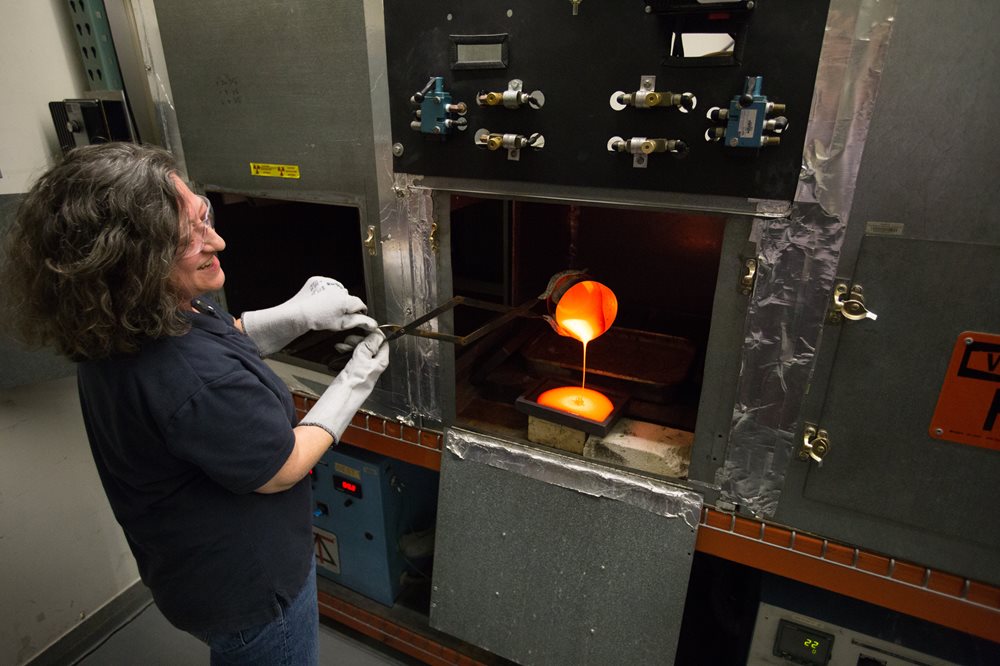
Photos: Andra Kidder conducting vitrification materials testing at Catholic University's Vitreous State Laboratory
Through a partnership with a company that VSL started and is now owned by SNC Lavalin, and with funding from the DOE, the team operates five pilot-scale melters like those at WTP in the basement of the lab. It is inside the walls of this five-story building that the vitrification process continues to be studied and optimized.
“At VSL, we have the largest array of test melters as well as the single largest test melter in the United States,” said Pegg. “The biggest melter is a one-third prototype of the WTP high-level waste melter that is fitted with a prototypical off-gas treatment train. Over many years, VSL worked closely with the Bechtel and SNC Lavalin designers to test, improve, and validate the designs for key systems that will operate at WTP.”
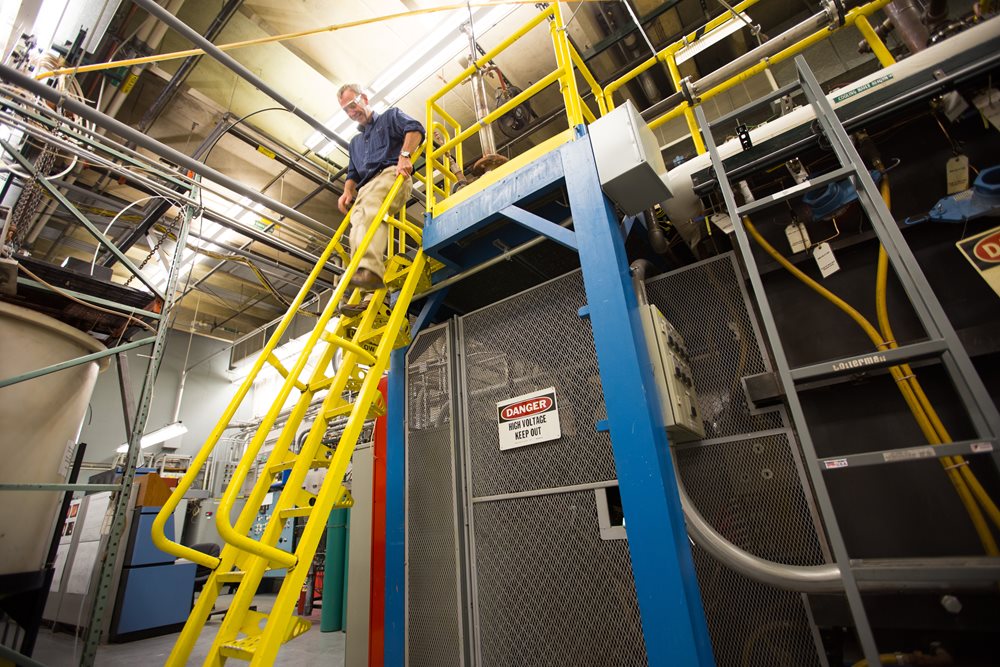
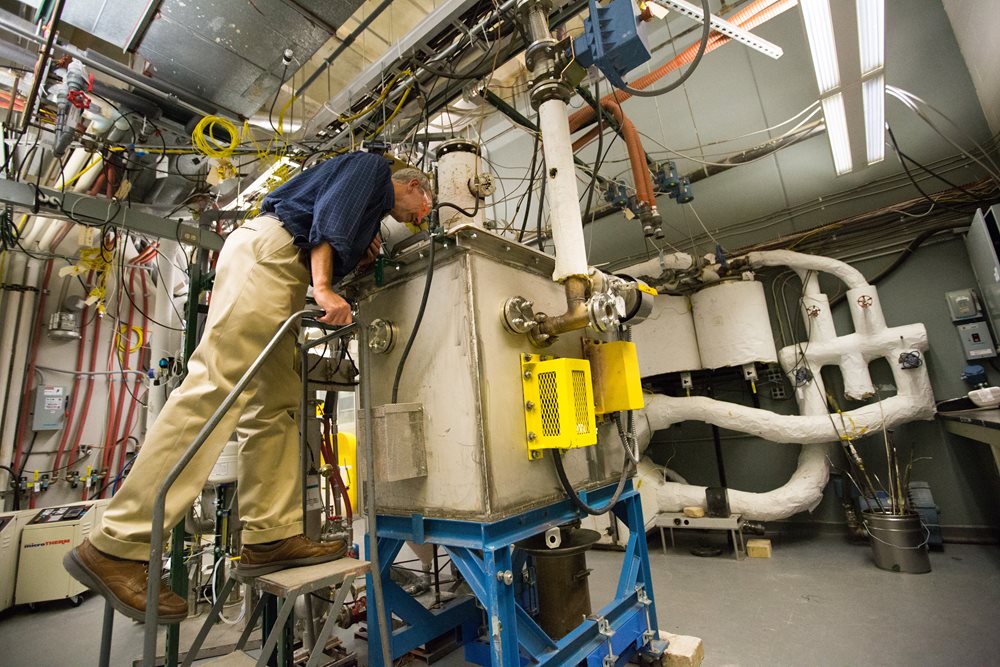
Photos: Ian Pegg, PhD, inspects two melters at Catholic University of America. The melters have helped inform the design of much larger melters at WTP.
New Technology Advances Process
In the early 1990s, VSL scientists developed a game-changing technology that revolutionized the melters’ ability to vitrify waste. Dubbed “bubblers,” this technology injects gas bubbles into a molten mixture inside the melter from an organized array of tubes, transferring momentum to increase mixing, and more importantly, the spread of heat. No cool spots remain as the molten material circulates around the melter and from top to bottom.
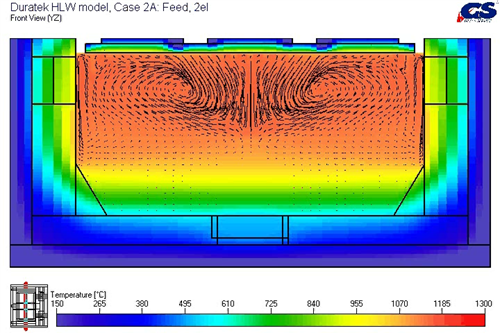
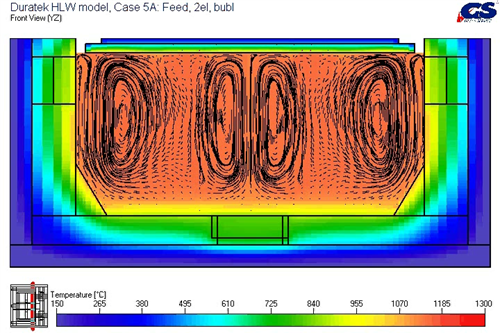
The higher rate of feed-to-glass conversion boosts glass production by a factor of five. With the acceleration in production, the Hanford cleanup effort is reduced considerably compared to conventional vitrification technology. DOE’s investment is saving U.S. tax dollars.
“Both the cost and the duration for waste vitrification at Hanford would have vastly increased without the bubbler technology,” said Pegg.
In past DOE clean-up efforts, bubbler technology has shown great impacts to the project schedule. In 2010, the VSL bubbler technology was introduced into the DOE’s Defense Waste Processing Facility’s (DWPF) vitrification system at the Savannah River Site in South Carolina. The installation of the new technology greatly increased the melter throughput. Although the technology at WTP is not quite the same, the advancements made at DWPF provide scientific data that will help inform its use at WTP.

Photo: A viewing port in a melter at Catholic University of America shows a bubbler at work.
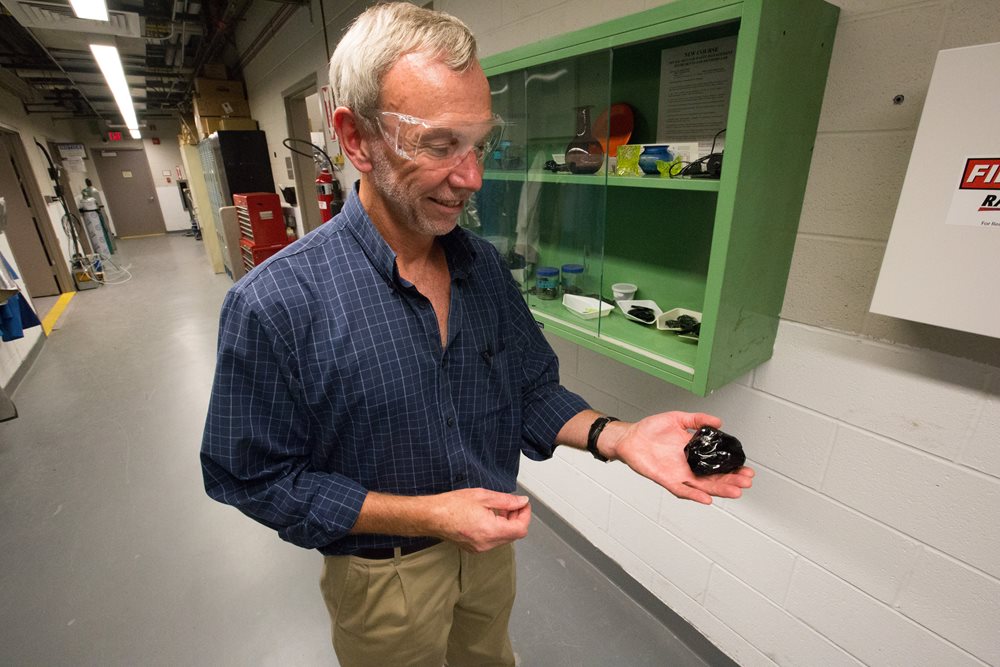
Photo: Pegg holds a sample of vitrified glass from a Catholic University of America melter
“It’s so satisfying to see our work being put into practice in these facilities; it’s the connection of research conducted at the VSL to real applications that sucked me in,” said Pegg.
A Recipe for Success
With so much radioactive waste at Hanford, vitrification using one melter like those used at other waste sites in Europe or New York state would take thousands of years to complete, far too long to protect the river and neighboring cities and towns, Pegg said. Following the testing and commissioning process, DOE will begin operating the first phase of WTP, the vitrification facility for low-activity waste, under the so-called “direct feed low activity waste (DFLAW)” flow-sheet by 2023, which is a current focus of VSL’s work. Low-activity waste makes up more than 90 percent of the volume of the material in the tanks." The particularly complex contents of the onsite sludge, which include the most dangerous radioactive species, will be treated later.
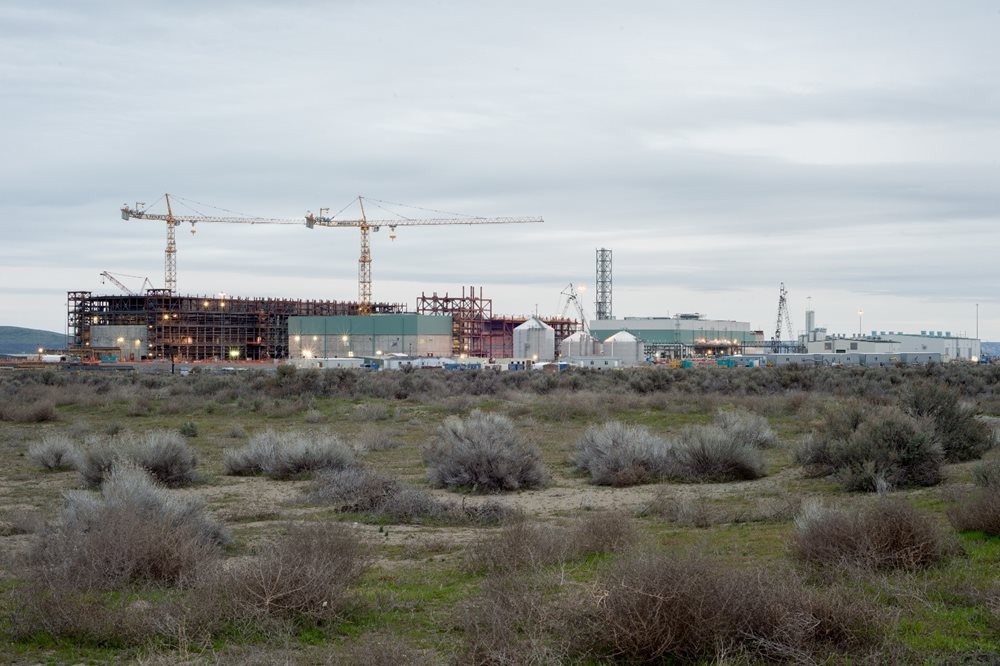
The vitrification facilities need recipes that define the correct mixtures of glass forming materials to be added to each batch of waste to ensure that the melters operate correctly and all of the product quality requirements are met. VSL developed the glass recipes and worked with Pacific Northwest National Laboratory and Savannah River National Laboratory on the supporting statistics and process control plan to produce qualified glass, with Bechtel as the integrator.
“The glass formulation optimization work conducted over many years has helped define the operating envelope for the WTP vitrification facilities in terms of the recipes that will be used for these diverse wastes,” said Pegg.
Looking to further improve the performance of the WTP, VSL researchers saw an opportunity to significantly reduce the amount of glass produced during the cleanup effort. Working with the DOE and Bechtel experts, they developed breakthrough LAW and HLW glass formulations that are able to incorporate much more waste, greatly reducing the amount of glass produced. It is expected that this “better glass” approach will be implemented sometime after commissioning is complete and startup has begun.
“The new glass formulations meet all of the processing and product quality requirements, but pack more waste into each canister and are therefore much more economical,” said Pegg.
Improving the Environment for Future Generations
Vitrification of low-level waste at WTP will begin as early as 2023, and will use all of these technologies in a collaborative approach by the DOE to foster continuous improvement of the clean-up effort. Coined as “the single greatest engineering cleanup challenge in the world” in 2016 by then-Energy Secretary Ernest Moniz, the technical approach to WTP is strengthened by collaborations from across the U.S – all working toward a common goal: to ensure a safer world for future generations.
“There is a little bit of nobility in it,” Bowan said. “This is a big environmental threat, and we’re changing it to a form where humans won’t have to worry about it anymore.”

